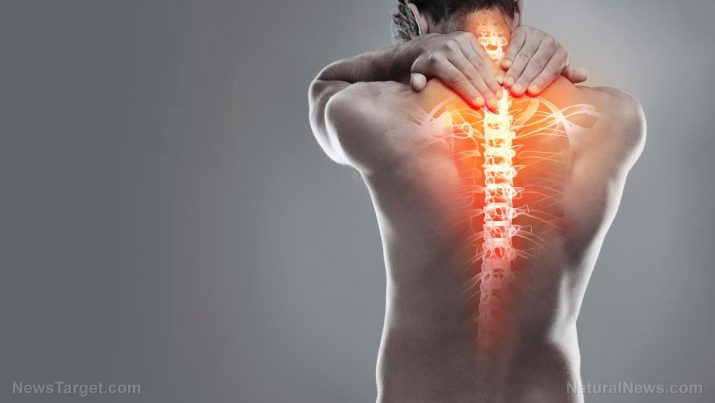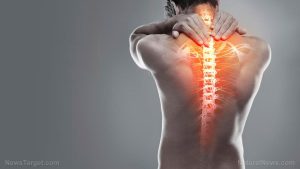
Spinal stenosis – causes, side effects and treatments at NaturalPedia.com
Monday, July 02, 2018 by Zoey Sky
http://www.naturalpedia.com/spinal-stenosis-causes-side-effects-and-treatments-at-naturalpedia-com.html

Spinal stenosis refers to the narrowing of the bone channel that is occupied by an individual’s spinal cord/spinal nerves. Stenosis can happen anywhere along the spine and how much of the spine is affected may vary per patient.
“Stenosis” means the abnormal narrowing of a body channel.
The bone channel narrows gradually and if the narrowing is minimal, a patient doesn’t usually experience any symptoms. However, if the channel gets too narrow, the nerves may get compressed and this can result in various problems.
Spinal stenosis is usually caused by aging since degenerative processes happen all over the body as it ages. Tissues in the spine may start to thicken, and bones may enlarge, which can compress the nerves.
Spinal stenosis is also known as central spinal stenosis, foraminal spinal stenosis, and pseudo-claudication.

Known symptoms of spinal stenosis
The signs of spinal stenosis, which can progress over time as the nerves get more compressed, usually include:
- Balance problems
- Leg or arm weakness
- Lower back pain while standing or walking
- Numbness in the buttocks or legs
A patient can sit in a chair to help relieve these symptoms, but they will recur once the individual stands or walks.
Individuals who already have osteoarthritis and rheumatoid arthritis are at risk of developing spinal stenosis. The inflammation that these conditions cause may put added pressure on the spinal cord.
Other conditions that may cause stenosis include:
- Achondroplasia (a type of dwarfism)
- Bone tumors
- A naturally narrow spinal cord
- Paget’s disease of the bone (this causes abnormal bone destruction and regrowth)
- Scoliosis/spinal curvature
- Spine defects present at birth
Body systems harmed by spinal stenosis
Spinal stenosis may cause the following complications:
- Claudication – This refers to the weakness of the legs that worsens while a person is walking. Claudication is either caused by the narrowing of the blood vessels supplying the leg or spinal stenosis.
- Incontinence (loss of bladder control)
- Paralysis
Food items or nutrients that may prevent spinal stenosis
The following foods or nutrients can help prevent spinal stenosis or address its symptoms:
- Carbohydrates and fats – Maintaining a healthy weight can help relieve pressure on your back and reduce leg pain and numbness. Low-fat foods with complex carbohydrates can keep you energized without making you gain weight. Low-fat foods include fruits, legumes, oatmeal, vegetables and whole-wheat bread. Consume more food with plant-based fats, such as olive oil, instead of foods rich in animal-based fats (e.g., butter).
- Fluids – Drinking enough fluids will also help your spinal discs stay hydrated. These discs cushion between the vertebrae, and they help promote movement in the spinal joints. Stay hydrated by drinking enough water, calorie-free-, or low-calorie beverages in a day. Try to limit your intake of or avoid caffeinated drinks and alcohol, which can cause dehydration.
- Protein – Foods rich in protein helps your body maintain muscle tissues. The muscles and ligaments in your back help support the spine and they help you maintain proper posture. Protein-rich foods include beef, chicken, dairy products, eggs, fish, and nuts. You can maintain a healthy weight by eating low-fat sources of protein like fish or poultry.
- Vitamins and minerals – Getting enough vitamins and minerals may reduce inflammation in the spine and the pain caused by spinal stenosis. Foods rich in vitamins A, C, and D, B-complex vitamins, and calcium include beef, chicken, citrus fruits, dark green vegetables, eggs, milk, and orange and yellow vegetables and fruits.
Treatments, management plans for spinal stenosis
Treatments for spinal stenosis include surgery and physical therapy.
Surgery may be required if a person suffers from pain caused by the condition or if there is a neurological loss. Some procedures can relieve pressure permanently.
These surgical procedures can help treat spinal stenosis:
- Foraminotomy – This procedure helps widen the part of the spine where the nerves exit.
- Laminectomy – The most common type of surgery, this involves the removal of part of the vertebrae to give the nerves more room.
- Spinal fusion – This procedure is usually suggested for serious cases, especially when multiple levels of a patient’s spine are involved. A spinal fusion prevents instability. During the procedure, bone grafts or metal implants are used to attach the affected bones of a patient’s spine together.
Physical therapy is a non-invasive treatment option for patients with spinal stenosis. It can help strengthen muscles and gently stretch an individual’s body.
Where to learn more
- The 5 Best Home Remedies for Joint Inflammation
- 7 Home Remedies That Are Beneficial In The Treatment of Sciatica
- Painkiller usage reduced by 50 percent with homeopathy
- Top 3 Causes of Sciatica
- Try These 3 Amazing Natural Killers for Chronic Pain
Summary
Spinal stenosis refers to the narrowing of the bone channel that is occupied by an individual’s spinal cord/spinal nerves.
The signs of spinal stenosis usually include balance problems, leg or arm weakness, or lower back pain.
Spinal stenosis may cause complications like claudication, incontinence, and paralysis.
Treatments for spinal stenosis include surgery and physical therapy.
Sources include:
Tagged Under: Tags: spinal stenosis





